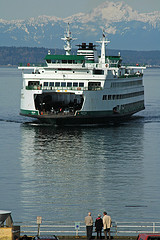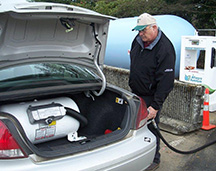As a leader in sustainability, the Washington State Department of Transportation (WSDOT) has been working for many years to incorporate the concept into all aspects of its work.
WSDOT defines sustainable transportation as a system that “preserves the environment, is durable, takes into account how we build and the materials we use and is managed and operated using policies and strategies that meet society’s present needs without compromising the ability of future generations to meet their own needs.”
WSDOT Secretary Paula Hammond has stated that the agency’s sustainability effort is not a program. The secretary sees it as an ethic and wants it embraced throughout the agency by finding new ways to extend the life of assets, invest wisely, and work efficiently.
Agency Organization
The emphasis on sustainability as an agency-wide priority is reflected in how the department is organized, according to WSDOT Sustainable Transportation Manager Seth Stark. WSDOT seeks to integrate sustainable practices in every facet of its work, from long-range plans to day-to-day operations. Stark points out that while he reports to Secretary Hammond, he also coordinates the Sustainable Transportation Leadership Team made up of five different agency directors representing such divergent areas as Environmental Services, Maintenance and Operations, Planning Public Transportation, and a Regional Office.
The sustainability efforts also support Secretary Hammond’s Moving Washington strategy, the agency’s investment framework for developing an integrated transportation system for the 21st century. The strategy focuses on three key elements: operate the system efficiently; manage demand on the system; and add capacity strategically. “By considering the impact of the state’s system on the economy, the environment and communities in a cost-effective and resource responsible manner we act responsibly and sustainably,” according to a WSDOT description of its strategy.
Secretary Hammond has explained the interconnectivity of the Moving Washington framework and the agency ethic of sustainability as, “Moving Washington is what we do, and sustainability is how we do it.”
Empowering Employees
A key to the incorporation of sustainability into WSDOT’s day-to-day decision-making is the Secretary’s Executive Order “Business Practices for Moving Washington.” The order calls on all employees to incorporate business practices that guide them toward innovation, sustainability, efficiency, and resource management in their daily work. It empowers employees to act sustainably, to get every benefit, every efficiency, and the best use out of the department’s limited resources. According to Stark, “Viewing each employee as the front-line specialist of their own work leads to the simple question, ‘Is there a better way, a more efficient way, a more cost effective way to do this task or make this decision?’”
WSDOT employees are further empowered through an additional supporting directive to agency executives, managers and supervisors to create a workplace culture and process that encourages employees to recommend sustainability initiatives.
Another effort in support of the agency’s sustainability goals is the agency’s work with the “Lean” process improvement system. The Lean system builds on efficiency and performance improvement methods already taking place at WSDOT to develop a culture that encourages employee creativity and problem-solving skills, Stark said.

Efforts to empower WSDOT employees already are paying of. For example, three Washington State Ferries (WSF) employees collaborated to identify a method to save fuel on one of the largest vessels in the system. The employees studied the effect of vessel speed on fuel consumption and suggested revised throttle settings to maximize fuel efficiency. Following a successful pilot project, WSDOT management adopted and implemented their suggestion, which is now the operating standard for the vessels on the route. These fuel conservation efforts – which also helped reduce vessel exhaust emissions – were honored with AASHTO’s 2012 America’s Transportation Award.
“Thanks to the ingenuity of these employees, WSF found a way to conserve fuel and save money without sacrificing on-time performance or a commitment to customer service,” Secretary Hammond said.
Sharing Sustainable Practices
A wide range of sustainable practices are described on the agency’s Sustainable Transportation website, including a series of “folio” fact sheets developed to educate and inform the public. Examples of WSDOT’s sustainable practices cut across a broad range of focus areas:
- improving mobility and traffic operations with the installation of electronic, variable speed limit and lane status signs, electronic tolling, ramp meters, roundabouts and high occupancy vehicle lanes;
- conserving fuels and energy through the West Coast Green Highway Initiative to support the use of electric and alternative-fuel vehicles; upgrading WSDOT vehicle fleet; and installation of solar-powered traffic control systems;
- promoting economic vitality and stewardship by addressing key traffic chokepoints, investing in rail, separating freight from rail and light-vehicle traffic around ports, and boosting incident response and traffic management;
- focusing on preservation and maintenance of the existing system by promoting longer lasting pavements, using recycled materials, using native plants, and using “precision” roadway salt applications in winter months to minimize amount of salt needed;
- improving safety by installing cable median barriers, cleaning catch basins and drains to prevent flooding, retrofitting bridges and structures to withstand earthquakes, and building roundabouts to improve traffic flow and reduce the risk of collisions;
- improving design and construction techniques with innovative engineering for structures that can endure a harsher climate, and innovative contracting for more efficient project delivery;
- protecting and enhancing the environment by removing fish passage barriers, addressing stormwater pollution by preventing erosion and filtering runoff, connecting wildlife habitat, and restoring natural vegetation;
- advancing community partnerships by integrating bicycle and pedestrian elements into highway projects and increasing investments to promote carpools, vanpools, transit, and telecommuting; and
- reducing emissions linked to climate change through efforts focused on operating the system efficiently, lowering the carbon content of fuels, supporting improved vehicle technologies, and supporting a variety of transportation options.
Other examples are detailed here.

Dan Dollar, WSDOT’s Southwest Region fleet superintendent, fuels up a Ford Taurus, one of 21 WSDOT fleet vehicles being retrofitted to run on propane autogas and regular gasoline. Each $5,000 retrofit includes installing a propane tank in the trunk if it’s a passenger vehicle.
Adaptation Seen as Key Element
According to Stark, a key initial step that many DOTs can do regardless of where they are on implementing sustainability and climate change initiatives is the work that WSDOT has done through its climate change adaptation efforts. “Maintaining and preserving our existing system is central to providing a system that is sustainable,” Stark said.
“People throughout our agency are more frequently confronted with negative impacts from the increasing frequency of extreme weather events,” he said. WSDOT has performed a statewide infrastructure vulnerability assessment that identified all state-owned transportation facilities that are at risk.
“Through a scenario-based approach, WSDOT was able to recognize that while a lot of our system is resilient, we still have facilities where we need to be more sustainable,” he added.
By instituting an agency-wide sustainable transportation ethic, WSDOT aims to help target its limited resources on the state’s most pressing transportation needs.
For more information on WSDOT’s sustainability transportation program, contact Seth Stark at [email protected].

